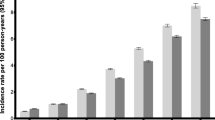Abstract
Objective: Evaluate the prevalence of hyperkalemia(potassium < 5.5 mmol/l) in hospitalized patientsnot on dialysis, as well as the association ofmedications, impaired renal function and comorbidconditions with hyperkalemia.Design: A retrospective case-control method.Setting: A tertiary care teaching hospital.Patients: Hyperkalemic adults not on dialysis withage and sex matched controls.Interventions: None.Main outcome measures: The use of medicationsassociated with hyperkalemia and renal function usinga calculated creatinine clearance were compared in thehyperkalemic and control groups.Results: 35 adult patients with hyperkalemia who werenot receiving dialysis were identified, with aprevalence in the hospitalized population of 3.3%.The hyperkalemic patients were older than the generalhospital population (p < 0.05). Compared withcontrols, hyperkalemic patients: had a lowercreatinine clearance (p < 0.05), were more likely tobe taking angiotensin-converting enzyme inhibitors (p < 0.05), and had an increased frequency of diabetesmellitus (p < 0.001). All of the control patientssurvived their hospitalization, but the mortality rate in the hyperkalemic group was 17% (p < 0.0001). Noneof the deaths were directly attributable to hyperkalemia.Conclusions: Hyperkalemia is more frequent in olderpatients and is usually mild. Hyperkalemia isassociated with diabetes mellitus, diminished renalfunction and the use of angiotensin-converting enzymeinhibitors. An elevated serum potassium level in ahospitalized patient may be a marker for asignificantly increased risk of death, which is due tounderlying medical problems and is not a consequenceof the hyperkalemia.
Similar content being viewed by others
References
DuBose TD. Hyperkalemic hyperchloremic metabolic acidosis: pathophysiologic insights. Kidney Int 1997; 51: 591–602.
Cohn JN. The management of chronic heart failure. N Engl J Med 1996; 335: 490–498.
Hennekens CH, Albert CM, Godfried SL, Gaziano JM, Buring JE. Adjunctive drug therapy of acute myocardial infarctionevidence from clinical trials. N Engl J Med 1996; 335: 1660–1667.
Epstein M. Aging and the kidney. J Am Soc Nephrol 1996; 7: 1106–1122.
Levinsky, NG. Hyperkalemia. N Engl JMed 1966; 274: 1076–1077.
Schlessman JJ. Sample size requirements in cohort and casecontrol studies of disease. Am J Epidem 1974; 99: 381–384.
Cockroft DW, Gault MH. Prediction of creatinine clearance from the serum creatinine. Nephron 1976; 16: 13–18.
Saggar-Malik AK, Cappuccio FP. Potassium supplements and potassium-sparing diuretics: A review and guide to appropriate use. Drugs 1993; 46: 986–1008.
Ahmed EU, Mohammed BN, Matute R and Burns GC. Etiology of hyperkalemia in hospitalized patients: An answer to Harrington' question. J Am Soc Neph 1998; 9: 103A.
Rosa RM, Batlle D. Hyperkalemia. In: Jacobson HR, Striker GF, Klahr S, editors. The Principles and Practice of Nephrology. St Louis: Mosby-Year Book, 1995: 911–917.
Reardon LC, Macpherson DS. Hyperkalemia in outpatients using angiotensin-converting enzyme inhibitors. Arch Intern Med 1998; 158: 26–32.
Mulkerrin E, Epstein FH, Clark BA. Aldosterone responses to hyperkalemia in healthy elderly humans. J Am Soc Nephrol 1995; 6: 1459–1462.
DeVita MV, Han H, Chan R, Zabetakis PM, Gleim GW, Michelis MF. Drug use and the elderly in relation to changing etiologies of hyperkalemia. Geriatric Nephrology Urology 1991; 1: 41–45.
Goodfriend TL, Elliott ME, Catt KJ. Angiotensin receptors and their antagonists. N Engl J Med 1996; 334: 1649–1654.
Author information
Authors and Affiliations
Rights and permissions
About this article
Cite this article
Dunlay, R.W., Stevens, M.S. Hyperkalemia in hospitalized patients. Int Urol Nephrol 32, 177–180 (2000). https://doi.org/10.1023/A:1007135517950
Issue Date:
DOI: https://doi.org/10.1023/A:1007135517950




